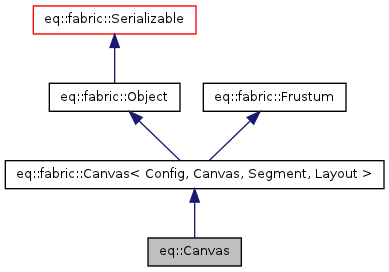|
Equalizer 1.0
|
eq::Canvas Class Reference
A canvas represents a logical 2D projection surface. More...
#include <canvas.h>
 Inheritance diagram for eq::Canvas:
Inheritance diagram for eq::Canvas: Collaboration diagram for eq::Canvas:
Collaboration diagram for eq::Canvas:Public Member Functions | |
| Canvas (Config *parent) | |
| Construct a new canvas. | |
| virtual | ~Canvas () |
| Destruct this canvas. | |
Data Access | |
| ServerPtr | getServer () |
Detailed Description
A canvas represents a logical 2D projection surface.
A canvas consists of one or more Segment, which represent the physical output channels. Segments have a viewport, which defines which part of the logical 2D projection surface they occupy. Segments overlap each other when edge-blending is used, and have gaps for display walls. Passive stereo systems use one segment for each eye pass, so that two segments have the same viewport. Application windows typically use one canvas per Window.
A canvas has a Frustum, which is used to compute a sub-frustum for segments which have no frustum specified. This is useful for planar projection systems.
A canvas has one ore more layouts, of which one Layout is the active layout, defining the set of logical views currently used to render on the canvas. The layout can be switched at runtime. A canvas with a 0 layout does not render anything, i.e., it is not active.
- See also:
- fabric::Canvas for public methods
Constructor & Destructor Documentation
| eq::Canvas::Canvas | ( | Config * | parent | ) |
Construct a new canvas.
- Version:
- 1.0
| virtual eq::Canvas::~Canvas | ( | ) | [virtual] |
Destruct this canvas.
- Version:
- 1.0
Reimplemented from eq::fabric::Canvas< Config, Canvas, Segment, Layout >.
Member Function Documentation
The documentation for this class was generated from the following file:
 1.0 by
1.0 by
 1.7.3
1.7.3

